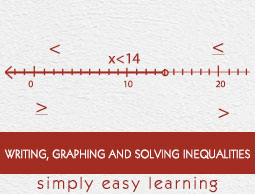
- Writing, Graphing and Solving Inequalities
- Home
- Translating a Sentence by Using an Inequality Symbol
- Translating a Sentence into a One-Step Inequality
- Introduction to Identifying Solutions to an Inequality
- Writing an Inequality for a Real-World Situation
- Graphing a Linear Inequality on the Number Line
- Writing an Inequality Given a Graph on the Number Line
- Identifying Solutions to a One-Step Linear Inequality
- Additive Property of Inequality with Whole Numbers
- Multiplicative Property of Inequality with Whole Numbers
- Solving a Two-Step Linear Inequality with Whole Numbers
- Solving a Word Problem Using a One-Step Linear Inequality
Solving a Two-Step Linear Inequality with Whole Numbers
Solving inequalities is similar to solving equations. What we do on one side of an inequality, we do the same on the other side to maintain the “balance” of the inequality. The Properties of Inequality help us add, subtract, multiply, or divide within an inequality.
As with one-step inequalities, we solve two-step inequalities by manipulating the inequality so as to isolate the variable.
Similarly, we always substitute values into the original inequality to check the answer. We plug in the solutions obtained into the original equation and see if it works.
Inequalities model problems that have a range of answers. They can be mapped along a number line, and they can be manipulated to simplify or solve them. When solving inequalities, it is important to follow the Properties of Inequality −
Solve the following two-step linear inequality with whole numbers.
5y + 1 > 11
Solution
Step 1:
Given 5y + 1 > 11; Subtracting 1 from both sides
5y + 1 −1 > 11 – 1; 5y > 10
Step 2:
Dividing both sides by 5
5y/5 > 10/5; y > 2
Step 3:
So, solution for the given two-step linear inequality is
y > 2
Solve the following two-step linear inequality with whole numbers.
$\frac{−x}{2}$ − 5 > 2
Solution
Step 1:
Given $\frac{−x}{2}$ − 5 > 2;
Adding 5 to both sides
$\frac{−x}{2}$ − 5 + 5 > 2 + 5; $\frac{−x}{2}$ > 7
Step 2:
Multiplying both sides by 2
−x/2 × 2 > 7 × 2; −x > 14; x < −14
Step 3:
So, solution for the given two-step linear inequality is x < −14